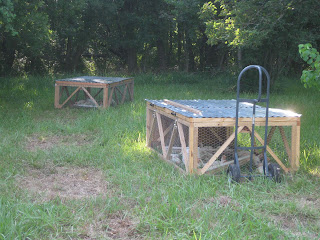We processed our Cornish Cross this week. They were just over six weeks old.
At the end, 31 birds survived to die an unnatural death. Five birds died in the
fifth week, and we don't know why. We cut back their feed and that seemed
to help, but it could have just as well been the heat.
The processing was made much easier by some great resources on the
web. Herrick Kimball, famous among backyard raisers for
his whizbang chicken plucker, has a website with step by step
instructions for how to butcher a chicken. There are also several
youtube videos that we found very useful, especially Joel Salatin
eviscerating a chicken and how they kill chickens at Polyface farm.
For more details we suggest you check them out, we will just cover our
personal experience.
Here is our basic setup.
You see the killing cones in the center back, the scalder to the right, a plucker
to the left, and a makeshift table for evisceration in the foreground.
Was it difficult killing a chicken? We cut the left and right carotid arteries while
leaving the trachea intact. This allows the bird to keep breathing and the heart
to pump blood out of the body longer. They say that the bird goes unconscious
after 5-10 seconds from blood loss and that all the flopping around after that is
just nerves. Because of this we were surprised to see the bird's eyes still focusing
and what could be interpreted as struggling to get out of the cone after half a minute.
After the birds were killed and blood drained, they went to the scalder.
Optimal water temperature is supposed to be between 140-150 Fahrenheit. Even within
that range the exact temperature could make a big difference in the time it took to scald,
and we got better results closer to 150. With the temperature at 150, it took us about
a minute and a half to get a good scald. The drawback of higher temperatures is that
the skin becomes more likely to tear during plucking.
With our setup it was difficult to maintain a steady temperature---the steady-state flame
was small enough that the wind could blow it out and then we would
have to re-light. We followed Herrick's advice and scalded until the tail and wing
feathers came out with no resistance. That seemed to work pretty well.
 |
| Testing a tail feather |
Next up was the plucker. We made a table top plucker. People say great things
about the whizbang tub plucker but it costs about $500 to make. We put
together the table top plucker for about $120.
Reading people's how-to descriptions they always say stuff like "we made this for $5 with
stuff we had lying around." The motor we had lying around.
Here is the plucker in action.
Plucking was definitely the most difficult part. It took a lot of spatial
reasoning to figure out how to orient the bird over the plucker to get the
feathers on the inside of the legs or under the wings. If the plucker's "fingers"
hit your fingers, it hurts. After 15 birds our technique improved, but we
found it faster anyway to just get most of the feathers with the plucker and
do the rest by hand. Now we really see the attraction of the whizbang plucker.
 |
| After the plucker, there are still some feathers left |
 |
| The bird all cleaned up |
The last step was evisceration. Contrary to what you might expect, this was one
of the easier and, dare I say, enjoyable steps of the process. It certainly was
educational to see how the organs of a chicken are laid out and there is an interesting
technical skill to learn here.
 |
| Chicken organs laid out. The blade is 4 inches. |
At the top you can see the esophagus (to the left) and the trachea. The
esophagus connects to the crop, which is inflated with air here. When
the Cornish were alive you could the crops bulging with food standing out from
their breasts. Below the crop you see the pink lungs, then the heart, liver and
the little green gall bladder peeking out behind the liver. The red silvery organ
is the gizzard, which is pretty interesting in itself. The gizzard connects to the
intestines, which finish at the vent there in the bottom left of the picture.
 |
| The gizzard |
 |
| This bird had a bunch of Tallow tree berries in his gizzard |
 | |
| The gizzard all cleaned up. |
leathery. Luckily, we learned this before we cooked them.
 |
| Gizzard with lining removed |




























